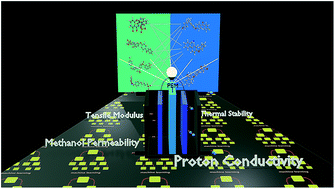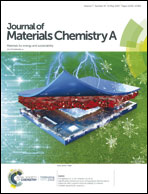Rational design of hydrocarbon-based sulfonated copolymers for proton exchange membranes†
Abstract
Developing novel hydrocarbon-based proton exchange membranes is at the Frontier of research on fuel cells, batteries and electrolysis, aiming to reach the demand for advanced performance in proton conductivity, fuel retardation, swelling, mechanical and thermal stability etc. Sulfonated copolymers are a class of highly focused materials used to fabricate proton exchange membranes. Sampling the space of chemical structure and architecture, as well as the composition of sulfonated copolymers, generated more than 2800 original reports (till June 2018), which highlight the feasibility and necessity to screen novel materials with computer-aided design strategies. Through an investigation of the 166 hydrophilic and 175 hydrophobic monomers that were used to build hydrocarbon-based sulfonated copolymers, correlation relationships among performance indexes and intrinsic properties of copolymers were explored. Reliable predictive models, in both regression and classification manners, for proton conductivity, methanol permeability, tensile modulus and degradation temperature were constructed and validated. Based on the top ranked monomers with superior performance and their optimal fractions and combinations, novel copolymers that have better predicted performance at a 0.05 significance level were presented. These predicted formulas provide directions for the synthesis of novel hydrocarbon-based sulfonated copolymers for advanced proton exchange membranes.

- This article is part of the themed collection: Editor’s Choice: Machine Learning for Materials Innovation


 Please wait while we load your content...
Please wait while we load your content...